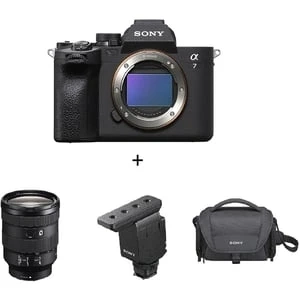The Sony A7 IV stands out as an excellent choice for those people, who are looking for a versatile hybrid mirrorless camera. It offers a modern and well-rounded experience that makes its price worthwhile. With top-notch autofocus, remarkable image quality, and robust video capabilities, this camera caters to a variety of needs in a single adaptable device. But for most users, the A7 IV is found to be a reliable solution with very few notable drawbacks, which makes it a potential go-to camera for a wide range of photography needs. Check out the features of the Sony A7 IV right below that you can buy at Sharaf DG.
Design
The Sony A7 IV might look similar to its previous version. However, it comes with various subtle improvements that enhance the overall user experience. At the top there is a better electronic viewfinder (EVF), that features a 3.69-million dot resolution and a 120fps refresh rate. While this is becoming standard in this price range (similar to what you will find on the Canon EOS R6), it is a much-needed upgrade, especially for smoothly tracking moving subjects.
Exploring the menus on the screen reveals Sony’s latest user interface (UI), first introduced in the Sony A7S III. These menus are a significant improvement over the complex ones found on older Sony Alpha cameras, and they respond to touch which makes navigation more user-friendly.
In terms of handling, the A7 IV’s grip feels more substantial than its predecessor, yet it remains familiar to anyone who has used an Alpha camera before. Below the mode dial, a new ring allows you to easily switch between stills, movies, and & mode (for slow-motion footage and time-lapses). In addition, there is a new dedicated red & record & button for video shooting and a lockable exposure compensation dial. These enhancements contribute to making the camera more enjoyable and convenient to use.
Image and Video Quality
While the Sony A7 IV’s new 33MP sensor might not lead to a dramatic improvement in image quality compared to the A7 III. It offers enhanced versatility rather than absolute image superiority. The higher resolution is found to be useful for those, who frequently crop their photos. But the increased number of megapixels also means smaller photosites on the sensor.
Sony addresses this by employing image processing to aid in low-light performance.
Despite the smaller photosites, the A7 IV impresses with its remarkable dynamic range, which provides flexibility in adjusting shadows in raw files even though it may introduce some noise in darker scenes. The out-of-camera JPEGs exhibit pleasing and true-to-life colors and well-rendered skin tones.
However, the most significant advancement over the A7 III lies in the A7 IV’'s video quality. Oversampling 4K/30p video from the sensor’s 7K resolution results in a notably sharp, noise-free image, even at ISO 12800. Moreover, the ability to shoot 4K in 10-bit 4:2:2 offers color graders greater flexibility than the Sony A7 III.
Autofocus and Features
The Sony A7 IV does not revolutionize full-frame mirrorless cameras as much as it is done by its predecessor. But its improvements bring it close to the capabilities of the Canon EOS R6. This makes it a great choice for a great range of photographers ranging from wildlife enthusiasts to wedding photographers.
The key to its enhanced performance is lying in the Bionz XR processor, which is shared with the high-end Sony A1. While lacking a stacked sensor like the A1, the A7 IV does not unlock the same burst-shooting capabilities. However, the processor introduces notable upgrades in Sony’s latest autofocus technology and a significantly improved buffer depth during burst shooting.
With its increased 33MP resolution, the A7 IV maintains a top burst-shooting speed of 10fps which is similar to the A7 III. Shooting lossless raw files reduces this speed to 5fps or 6fps, which further makes it slower than the Canon EOS R6.
Performance As mentioned in the earlier section about features, the Sony A7 IV is not exceptionally fast when it comes to continuous shooting. The decision to increase its resolution to 33MP counteracts the improvements of its new processor that result in the same 10fps maximum speed as the A7 III, even with compressed raw files.
However, it is important to consider the advantages of its outstanding autofocus system and ample buffer. When a camera consistently achieves sharp focus, extremely high frame rates may not be necessary to capture the perfect moment.
The Active Stabilisation mode, which combines electronic stabilization with its mechanical IBIS (In-Body Image Stabilisation), is quite effective and beneficial for handheld shooting or vlogging.
In terms of battery life, it is solid but not extraordinary. The official CIPA rating is 520 shots per charge when using the electronic viewfinder, which represents a 15% decrease from the Sony A7 III.
So reach out to UAE’s shopping platform called Sharaf DG to buy your desired camera.


